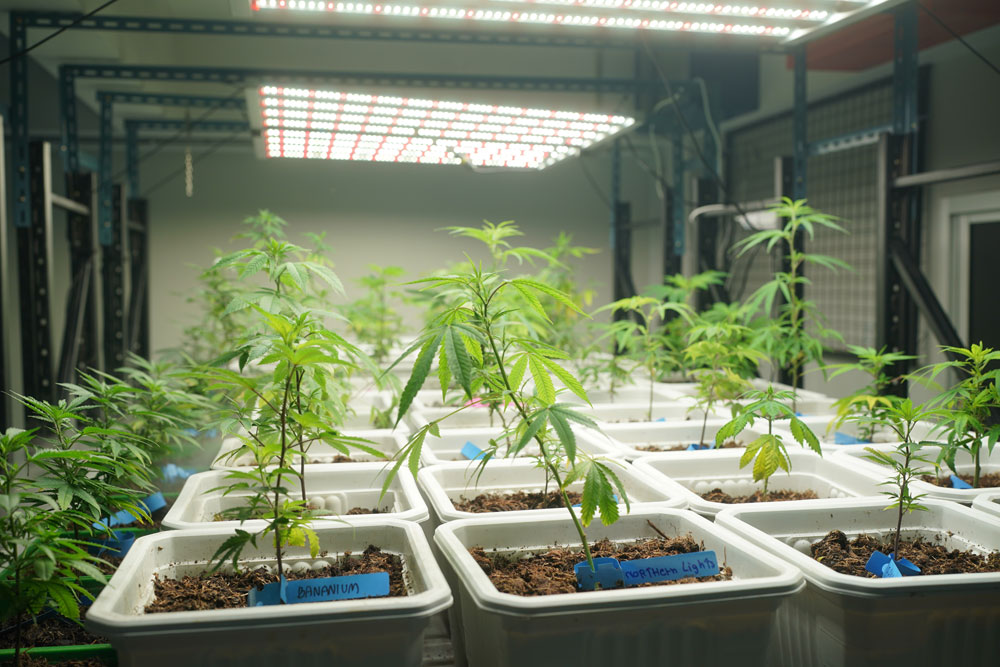When growing cannabis at home, there’s a lot more to it than watering and feeding plants and waiting for the premium flowers to grow. The best home growers train their plants and get the most from their cannabis grows by boosting yield and maximising space. Choosing the correct method can take your grow to the next level.
What is Cannabis Plant Training?
Simply put, cannabis plant training involves manipulating plants to ensure every growth site receives adequate light and nutrients. Different training methods can be used, such as low-stress training (LST) and high-stress training (HST). These can control the shape of your plant, encourage multiple colas, and even speed up harvest times.
This blog will explore when and how to use the best cannabis training techniques. It will help you find the proper method for your growing needs. Whether you’re a beginner looking for an easy way to boost yields or an experienced grower aiming for pro-level results, this article has you covered.
Join us as we delve into the world of cannabis plant training techniques!
|
Training Method |
Type |
Main Benefit |
|
|
0 |
LST |
Low Stress |
Even canopy, better light exposure |
|
1 |
HST |
High Stress |
Stronger stems, more bud sites |
|
2 |
SCROG |
Low Stress |
Maximizes light for bigger yields |
|
3 |
SOG |
Low Stress |
Quick harvests with small plants |
|
4 |
Topping |
High Stress |
Creates multiple colas |
|
5 |
Fimming |
Medium Stress |
More colas, bushier growth |
|
6 |
Mainlining |
High Stress |
Symmetrical, controlled structure |
|
7 |
Lollipopping |
Low Stress |
Focuses energy on top buds |
|
8 |
Defoliation |
Medium Stress |
Improves light penetration & airflow |
|
9 |
Super Cropping |
High Stress |
Strengthens stems & increases resilience |
Low-Stress Training (LST)
What Is LST:
LST involves gently bending and tying down branches to encourage horizontal plant growth.LST prevents the main cola from dominating, encouraging multiple bud sites to develop.
Why It Works:
LST is highly effective because it maximises light exposure by creating an even canopy. An added bonus? It’s beginner-friendly, works well in small grow spaces like tents, and minimises plant stress.
High-Stress Training (HST)
What Is HST:
HST is when a grower intentionally stresses the plant using topping, super cropping, or extreme bending. We will cover High-Stress Training further on.
Why It Works:
HST is effective because it forces the plant to redistribute energy, leading to stronger stems and higher yields. By doing this, the plant produces multiple flowering sites instead of one dominant cola. High-stress techniques are best suited to growers more comfortable taking higher risks.
The Screen of Green (SCROG)
What Is Screen of Green:
The screen of Green uses a horizontal net to train plants and control growth direction. Branches are weaved through the screen to spread out flowering sites evenly.
Why It Works:
Screen of Green is one of the best cannabis training methods to maximise light exposure. SCROG reduces plant height, making it ideal for indoors and any grower with limited vertical space. And for those looking to maximise crops with fewer plants.
Sea of Green (SOG)
What is Sea of Green:
Sea of Green is when many small plants grow close together instead of a few large ones. It focuses on developing a single main cola per plant rather than multiple branches.
Why It Works:
Sea of Green speeds up harvest time because the plants stay small but flower quickly, and it is a technique favoured by commercial growers and those who like autoflowers. SOG is ideal for growers looking for a quick turnover and dense canopy.
Topping
What Is Topping:
Topping is a lot like what it sounds and is when a grower cuts off the main growth tip of the plant to split it into two colas. Doing so forces the plant to grow outward instead of up.
Why It Works:
Topping is a great way to increase flower production by multiplying colas, and it helps create a more even canopy. Note: Topping is only recommended for photoperiod plants. So don’t go topping an autoflower.
Fimming/FIMing
What Is Fimming:
Fimming or FIMing is similar to topping, but you pinch or cut only part instead of cutting the main growth tip entirely. This method results in 4+ new growth shoots instead of 2.
Why It Works:
Fimming works well because it causes Less stress than topping and encourages bushier growth. It’s ideal for growers wanting a fuller canopy with additional flowering sites.
Mainlining (Manifold Training)
What is Mainlining:
Mainlining, or Manifold Training, is a structured technique where a plant is topped multiple times to create an even, symmetrical canopy.
Why It Works:
Mainlining works because it creates a well-distributed plant structure. Resulting in even flower development and high yields. If you’re a grower looking to maximise yield while maintaining a structured plant shape, this is the method for you.
Lollipopping
What is Lollipopping:
Lollipopping is when a grower removes lower leaves and small flowering sites so the plant focuses energy on top colas. This method ensures all nutrients go toward bigger, higher-quality flowers.
Why It Works:
Lollipopping works nicely to improve airflow and reduce the risk of mold. It also increases the density and potency of the flowers. Lollipopping is often used with SCROG, SOG or other HST methods.
Defoliation
What Is Defoliation:
To defoliate, strategically remove large fan leaves to increase light penetration and airflow. This plant training method is best employed during vegetative and early flowering stages.
Why It Works:
Defoliation prevents lower buds from being shaded and reduces humidity and mold risk. It’s an ideal method for experienced growers who understand when and how much to remove.
Super Cropping
What Is Super Cropping:
Super Cropping is bending branches until they slightly snap but do not break off. By causing tissue damage, it forces them to heal stronger, supporting bigger colas.
Why It Works:
Super Cropping creates thicker stems, increases nutrient flow, and trains plant shape without topping. It’s the ideal training method for growers wanting more resilient plants and maximum yields.
Final Tokes
Training cannabis plants is not all about getting the largest yield. It’s about the health of your plants and improving the quality and potency of the flowers. Whether using LST for gentle shaping, SCROG for maximising light exposure, or HST techniques like topping or super cropping for explosive growth, the proper method can take your grow to the next level.
The best cannabis harvest comes from knowledge, patience and technique. The more you know, the more you grow. So, experiment with new cannabis plant training methods, find out what works for you, and refine as you do.
Now, it’s up to you. Are you ready to grow your own legend with The Bulldog Seeds Collection?



